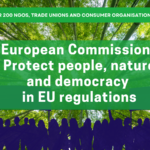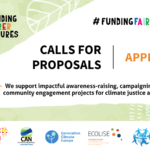The climate crisis, its impacts and the actions that are needed to rapidly slow it down and respond to it effectively require an intersectional, gender-responsive lens. The most recent and biggest scientific assessment, the 6th Assessment Report by the Intergovernmental Panel on Climate Change (IPCC), has given strong attention to equitable, just and enabling ways to address climate mitigation and adaptation, and how some of the climate crisis’ root causes, in particular the burning of fossil fuels, are embedded in injustice and inequity. This is based on the fact that structural inequities and unequal power relationships are key reasons why the climate crisis is particularly harmful for already marginalised segments of society. Europe and the EU must step up towards human-rights based climate action efforts in an effective, participatory and inclusive way. This requires an intersectional, decolonial, and gender-transformative approach to dismantle the roots of injustice and inequality, breaking down existing power relations between the sexes as well as between countries, conflicting economic interests and in other contexts. This has been lacking so far in the European Green Deal’s foreign policy dimensions, despite some positive elements to build from the EU’s Gender Action Plan for external action.
Insights from existing feminist foreign policies
According to the Centre for Feminist Foreign Policy (CFFP), Sweden’s adoption of a Feminist Foreign Policy (FFP) in 2014 “set in motion a growing movement”, with France, Spain, Mexico and Canada adopting FFPs. The Netherlands have recently embarked on a process to develop an FFP as well as a feminist development policy. The German Federal Foreign Office released its guidelines “Shaping feminist foreign policy” and the Federal Ministry for Economic Cooperation and Development (BMZ) which is by far the larger player when it comes to climate finance, recently presented its strategy for a feminist development policy (so far only in a German version), on 1 March 2023.
Many countries with feminist foreign policies are in one way or the other applying the “triple R” approach:
- Rights: promote all women’s and girls’ full enjoyment of human rights
- Representation: promote women’s participation and influence in decision- making processes at all levels
- Resources: work to ensure that resources are allocated to promote gender equality and equal opportunities for all women and girls to enjoy human rights
Several of the existing FFPs also include examples in the field of climate action and climate diplomacy. For example, promoting women’s participation and influence in decision-making across some of the international climate institutions, such as UNFCCC constituted bodies, is one important area of influence. Another is to improve the access to, and increase the volume of, climate finance resources for local groups and organisations with a strong focus on women’s rights and the rights of other often marginalised communities, such as those of Indigenous populations.
Climate-just Feminist Foreign Policies: more than a climate tick box
However, it has to be noted that it is essential that any Feminist Foreign Policy is committed to climate justice and addressing the climate crisis overall. It is not just one element, but it has to be at the core and one of the key areas for any Feminist Foreign Policy. Because the same elements that exploit women and any politically marginalized groups are also at the core of exploiting this planet and our environment. So the connection is pretty clear. At the same time it is exactly these multiple marginalized groups, predominantly Black, Indigenous and Women of Color, youth and elders that lead the feminist fight against the climate crisis. So any FFP that is true to its feminist elements must embrace and truly promote that.
Lack of a Feminist Foreign Policy approach to EU’s climate and energy diplomacy
In its recent EU Council meeting on 20 February, the EU’s Foreign Affairs ministers failed to adopt climate and energy diplomacy conclusions, which are regarded as a key tool of the EU’s approach to the external dimensions of the European Green Deal. CAN Europe presented key recommendations in advance of the meeting. Some media reports suggested this was mainly due to controversies over the inclusion of nuclear in the context of hydrogen promotion. The matter may be taken up during the next ministers’ meeting on 20 March.
Whether the conclusions would also indicate the EU stepping up on gender equality and feminist foreign policy terms remains to be seen. The climate and energy diplomacy conclusions are a key policy instrument that, unfortunately, in the last years (2019-2022) reflected more of a standstill in this area, with repetitive, vague language provisions merely committing to “continue to uphold, promote and protect gender equality and women’s empowerment.” Of course, whether the EU embraces a comprehensive approach to strengthening feminist foreign policy elements in its climate and energy diplomacy does not only depend on what ends up in the Foreign Affairs Council conclusions. Instruments such as the 3rd Gender Action Plan (GAP) are important starting points, but yet fail to be fully and consistently applied.
CAN Europe suggested for inclusion in the current EU climate and energy diplomacy conclusions the following key elements as starting points to gradually move to feminist climate and diplomacy approach:
- committing to “increase the full, meaningful and equal participation of women in climate action”, and commit to increased action to achieve this;
- increasing finance for, and access to, gender-just climate solutions led by grassroots and feminist organisations in the Global South;
- ensuring that gender justice is a mandatory component of monitoring and evaluating the EU’s progress on the external dimensions of the European Green Deal;
- ensuring gender justice is actively embedded in and integrated into all climate diplomacy work undertaken by the European External Action Service (EEAS).
This should be part of a more comprehensive commitment to a feminist foreign policy which aims to re-evaluate the entire economic rationale of hyper-capitalism and the power structures and colonial legacies embedded in the conception of international investments, traditional aid or assistance relationships, which have their own issues tied to postcolonialism and political economy interests. The application of a feminist approach demands a continuous dialogue, co-creation, and implementation of diverse actions and strategies together with civil society groups and movements from the Global South under an intersectional framing for environmental policies to benefit people equally. Analysing how social characteristics intersect with each other is fundamental to understanding how policies may and are leading to unique experiences of discrimination as well as the structural, historical and institutional root causes of such discrimination. It requires comprehensive transformational actions across the EU’s diplomacy toolbox, its financial instruments (including the EU budget Global Europe Instrument, its climate finance components and more specific initiatives such as the Global Gateway), its foreign policy institutions (such as the EU External Action Service, EEAS) and in various fields of international policy-making, under the UNFCCC, in relevant energy policy spaces, and beyond.
Of course, these need to be viewed in addition to, and embedded in, key climate action steps that need to be taken. This includes the need for the EU to raise its own mitigation ambition to levels compatible with 1.5°C (at least 65% reduction by 2030 and climate neutrality by 2040), and to increase new and additional climate finance to Global South countries with at least 50% going to adaptation, and additional resources for loss and damage, while terminating subsidies and support for fossil fuels. CAN Europe welcomes that various EU countries have adopted or embarked on feminist foreign policies (FFPs) including various climate components. But it is overdue that the EU moves towards a multidimensional, feminist climate diplomacy approach.



